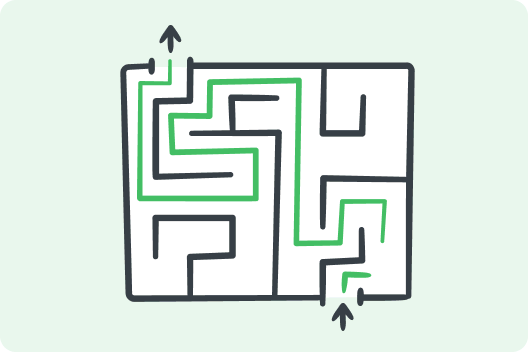In retail, growth and differentiation increasingly hinge on customer experience — and crucially, on how well brands listen to their customers. Customer feedback tools aren’t just a “nice to have”, they’re instrumental to the long-term health of a business.
But there are many feedback solutions to choose from, and before you decide on an option, it’s important to ask: How long until we see real, measurable results?
With Simplesat, results begin to emerge in just a few weeks. In our experience, most retail brands see a near-immediate uplift in survey response rates, CSAT/NPS scores, and clarity on customer pain points.
Quick wins retail brands can expect with Simplesat
1. Rapid increase in survey responses
One of the most striking effects is a steep jump in feedback volume. Retail brands switching from manual surveys or legacy systems frequently see their monthly response counts multiply by 4× to 5× within the first month.
This kind of accelerated response growth is driven by:
- Automated survey triggers with no manual sending
- One-click / embedded survey formats (low friction)
- Smart reminders nudging non-respondents without being pushy
Example
Shortly after launch, Sport Alliance increased from roughly 150 survey responses per month to 700–900 in just a few weeks.
2. Boosted CSAT & NPS scores
More responses give you better insight. But beyond volume, many retail brands see noticeable lifts in satisfaction and loyalty metrics soon after they start using Simplesat.
Surveys become easier to complete and are delivered at relevant moments, which means responses are fresh and genuine. Then, as brands begin to close loops — responding to feedback, fixing friction points, refining processes — CSAT and NPS scores tend to climb.
Of course, the goal isn’t to achieve perfect scores, it’s to discover and remove flaws in the CX. But in our experience, growing scores provide a morale boost to teams.
3. Sustained growth through iteration
That first spike in results leaves a big impression on our retail clients, but the real magic happens after.
To stand out in the retail industry, it’s crucial to
- iterate survey design,
- optimize timing,
- refine survey language,
- make feedback loops a part of your organization’s culture.
Simplesat’s real-time dashboards let teams track metrics monthly, compare segments, and test hypotheses. Over time, those small adjustments compound into consistent improvements in response rate, as well as insight depth and overall satisfaction.
4. What to expect: timeline & early signals
Here’s a rough guideline of what most retail brands see during their first 3 months with Simplesat:
| Period | What brands typically do / focus on | Early signals & results to watch for |
|---|---|---|
| Week 1 | Set up integrations (Gladly, Gorgias, Zendesk, Shopify, etc.), configure triggers, import customer data. | Surveys ready, minimal responses, dashboards start filling. |
| Week 2 | Soft rollout. Monitor subject lines, survey copy, timing; tweak as needed. | Feedback variety starts to appear. Response rate curve begins upward. |
| Week 3-4 | Full rollout on all targeted points, enable reminders, embed in emails/pages. | Big jump in feedback counts — some brands hit 4× to 5× growth. |
| Week 5-8 | Dive deeper: segment feedback, act on top issues, share insights. | CSAT/NPS averages rise; frequent themes emerge. |
| Week 9-12 | Test alternate triggers, refine timing, A/B subject lines, survey text. | Stabilization at new higher response levels; qualitative feedback deepens. |
| End of month 3 | Review month-on-month trends; present findings to stakeholders. | Clear story of growth, pattern of improvement, prioritized action points. |
By the end of a quarter, a retail brand often has enough data to map feedback to product, support, and operations changes.
Collecting customer feedback is only valuable if it’s easy for customers to share and effortless for teams to manage. Many legacy survey tools fall short: they create friction for respondents and add manual work for internal teams.
Simplesat was designed to remove those barriers. Retail brands see faster results because feedback flows naturally into existing workflows without slowing down operations.
- Native integrations — Simplesat connects with the platforms you’re already using, including Zendesk, Gorgias, Gladly, Freshworks, HubSpot, Shopify, and more. This means surveys are embedded right into everyday interactions instead of bolted on as an afterthought.
- Automated triggers — Surveys are automatically sent at the right time: after a purchase, a delivery confirmation, or a support resolution. That perfect timing makes feedback more relevant, boosting both response rates and accuracy.
- Embedded, one-click surveys — Instead of forcing customers to click out to a separate form, Simplesat embeds simple CSAT and NPS surveys into emails and chat interactions. One-click responses are a great way to collect fresh impressions.
- Smart follow-ups — For customers who don’t respond right away, Simplesat can send polite reminders that increase completion rates without feeling intrusive.
- Actionable dashboards — Real-time analytics let teams track progress, spot trends, coach support agents, and tie feedback to business outcomes.
- AI-powered topics — Open-ended comments are automatically scanned for keywords, themes, and sentiment, saving time and surfacing insights that teams might otherwise miss. Instead of digging through hundreds of comments, your team can quickly spot recurring issues or product opportunities.
This combination of automation, integrations, and intelligent analysis explains why retail brands adopting Simplesat see measurable improvements faster than with other survey tools.
Even with the best technology, execution matters. Here’s what your team can do to improve CSAT/CES/NPS scores and response rates.
- Send feedback requests immediately after key interactions. Timing is everything. The closer the survey is to the actual experience, the more accurate and thoughtful the response.
Read more: What is the best time to ask for feedback? - Keep surveys short and simple. Simplicity is a proven driver of higher response rates. One-question CSAT or NPS surveys, delivered with one-click response options, consistently outperform long, multi-page forms.
- Personalize requests instead of blasting generic surveys. Adding context — like referencing an order number or agent name — makes the survey feel more relevant. Simplesat’s integrations make personalization automatic.
- Close the loop, and do so visibly. Customers are more likely to respond again if they see their feedback led to change. Whether it’s a thank-you note, a product update, or a follow-up call, closing the loop reinforces that feedback matters.
- Involve the whole team. Feedback isn’t just for support leaders. Retail brands that share survey insights across marketing, product, and operations will soon see broader improvements. Simplesat dashboards make it easy to highlight trends and share wins company-wide.
- Track progress over time, not in isolation. Scores like CSAT and NPS matter most when viewed month-over-month or quarter-over-quarter. Benchmarking against past results clearly demonstrates progress to leadership, and it also keeps teams aligned and ensures transparency.
By pairing these best practices with Simplesat’s automated workflows, you can easily turn feedback into a strategic asset that drives both customer satisfaction and business growth.
Boosting survey response rates and improving CSAT and NPS scores is valuable on its own — but the real power of feedback is how it connects to business outcomes. For retail brands, better feedback means stronger loyalty, reduced churn, and higher revenue.
Better retention, less churn
Feedback highlights early warning signs before customers leave. By spotting friction, like delayed shipping or confusing product descriptions, brands can resolve issues proactively. McKinsey research shows CX leaders grow revenues 2–7% faster and increase profitability 1–2% above market average.
Cross-sell and upsell opportunities
Open-ended survey responses reveal deeper customer needs that can’t be expressed by numbers. A shopper might mention wanting faster delivery, a product accessory, or a subscription option. These insights create clear paths to increase average order value.
Reduced returns and lower service costs
Returns are expensive, and repeat issues (sizing, packaging, unclear details) pile up quickly. By using Simplesat’s AI-powered topics to scan for recurring problems in open comments, it becomes easier to pinpoint and fix systemic issues.
Stronger customer loyalty and repeat purchases
Acting on feedback builds trust. Customers who see their suggestions matter are far more likely to buy again and recommend the brand. McKinsey also reports that companies excelling at CX achieve higher retention and resilience, rebounding faster after downturns.
Efficiency and cost savings
Listening to customers prevents wasted resources. Instead of guessing what to fix, brands act on real data. Forbes notes that effective CX improvements can deliver up to 10% revenue growth and 25% cost reduction within 2–3 years.
⏱ How quickly do retail brands see results with Simplesat?
Most brands begin to see results in as little as 2-4 weeks. Many experience a 4-5× increase in survey response rates within the first month of launching Simplesat.
📈 How does Simplesat improve CSAT and NPS scores?
By making surveys short, simple, and perfectly timed, customers are more likely to respond honestly. As retail brands close the feedback loop and act on those insights, CSAT and NPS scores typically rise in the first few months.
🤝 Does Simplesat integrate with the tools retail brands already use?
Yes. Simplesat integrates natively with Zendesk, Shopify, Gorgias, Gladly, Freshworks, HubSpot, and many more. Surveys are embedded directly into existing workflows—no extra tools or manual effort required.
🛍️ Can customer feedback really drive revenue growth for retail brands?
Yes. Studies from McKinsey and Forbes show that customer experience improvements can lead to 2–7% revenue growth and up to 25% cost reduction within a few years. Simplesat helps retail brands achieve this by linking survey insights to actionable business improvements.
🔄 How do retail brands sustain feedback growth long-term?
The key is iteration. Brands that regularly test survey design, experiment with timing, and consistently close the loop maintain higher participation rates and deeper insights. Simplesat dashboards make tracking month-over-month improvements simple.
🤔 Can Simplesat capture both quantitative and qualitative feedback?
Absolutely. Simplesat collects quantitative data (CSAT, NPS, CES, 5-star ratings) and scans open-ended comments with its AI-powered topics feature. This reveals keywords, themes, and sentiment trends that help retail brands understand the “why” behind the scores.
📊 How do Simplesat dashboards help retail teams?
Dashboards provide real-time visibility into customer satisfaction trends, team performance, and recurring issues. Retail brands use them to coach agents, refine processes, and track progress across departments.
🌍 Is Simplesat suitable for global retail brands?
Yes. Simplesat surveys can be customized for different languages, channels, and regions. Retail brands with international customers use Simplesat to collect consistent, localized feedback at scale.
🚀 What makes Simplesat different from other survey tools?
Most survey tools require manual setup or push customers to long forms. Simplesat stands out by offering one-click surveys, automation, deep integrations, and AI-powered insights. This combination leads to faster results and higher response rates for retail brands.
About Simplesat: Simplesat is the leading omnichannel survey app designed to enhance customer feedback management across various platforms, including Zendesk, Salesforce, and Gladly. Trusted by businesses worldwide, Simplesat delivers actionable insights that drive business growth and customer satisfaction.




